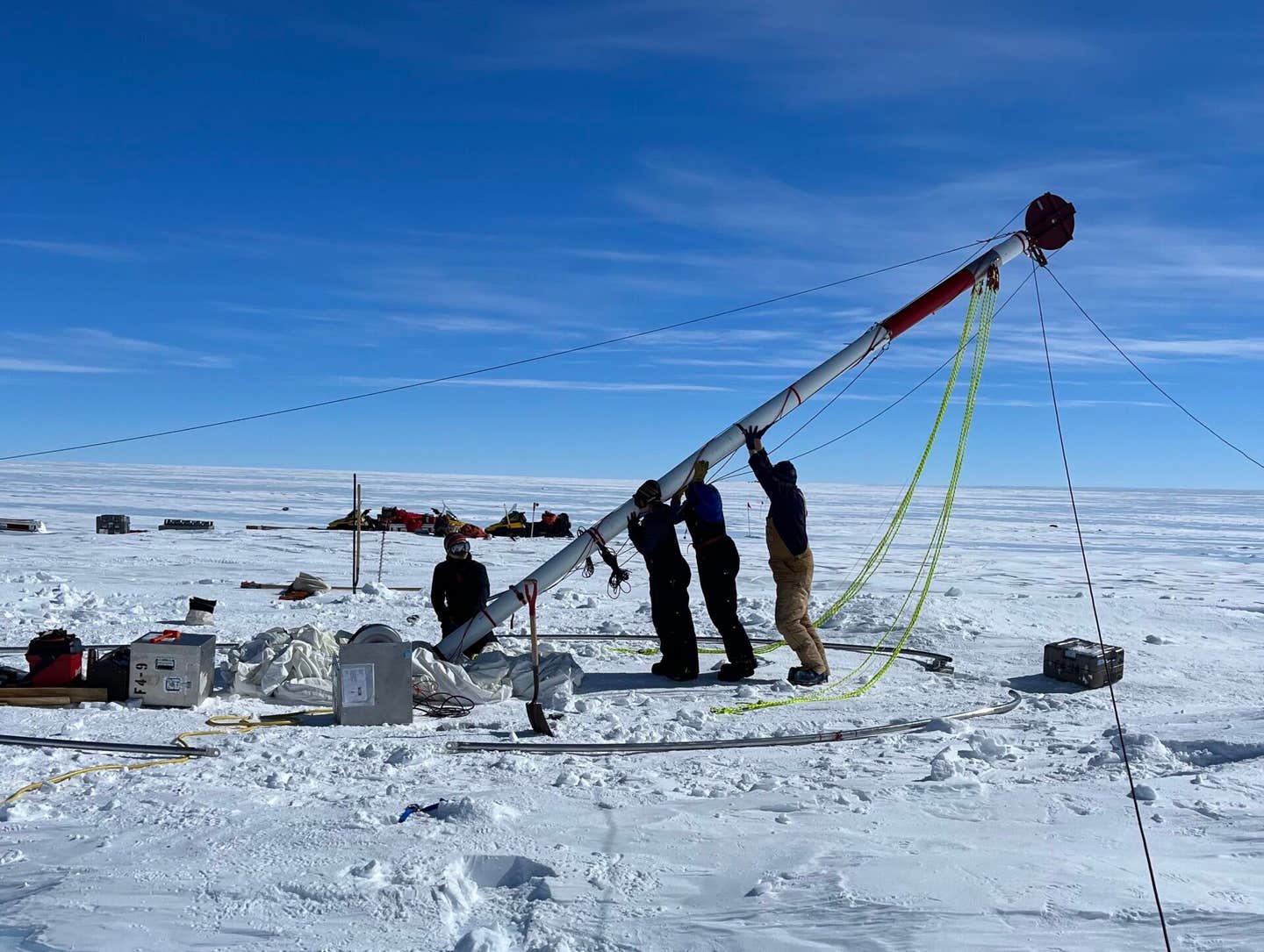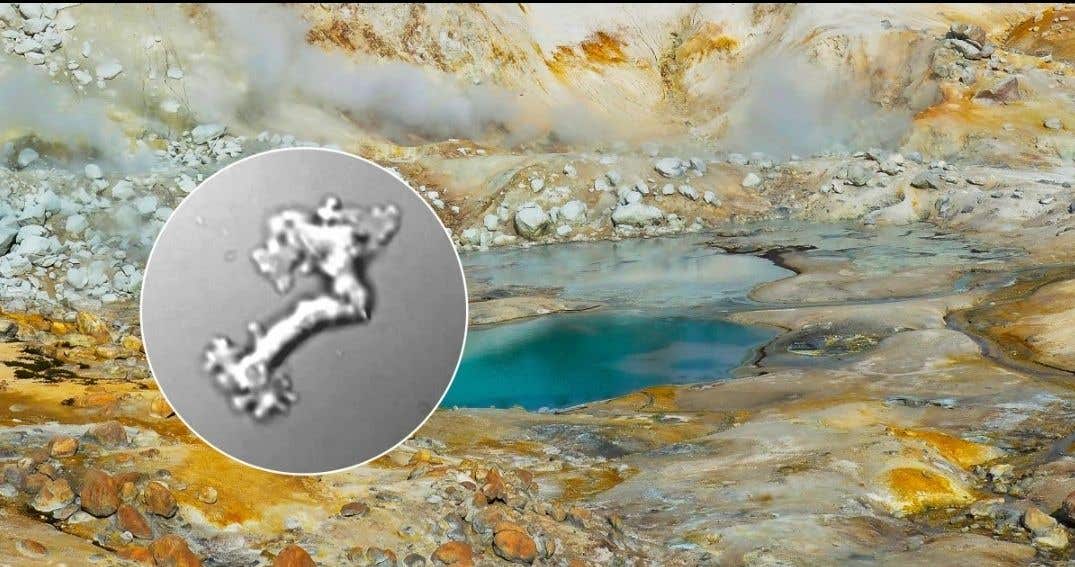Ancient Antarctic ice reveals six million years of Earth’s climate history
Scientists uncover six-million-year-old Antarctic ice, revealing Earth’s ancient climate and clues to future sea-level rise.

 Edited By: Joseph Shavit
Edited By: Joseph Shavit

Raising the Foro Drill, Allan Hills, Antarctica. 2022-2023. (CREDIT: Julia Marks Peterson, COLDEX)
At the edge of East Antarctica, where the wind howls through a white emptiness and the air bites harder than steel, scientists uncovered something so old it makes even time feel young. Beneath that endless blue lies ice, and the air inside it that hasn’t seen daylight for six million years.
Each bubble in that ice holds a breath from a vanished world. And when you think about it, really think about it, that’s almost spiritual. You’re holding air no human has ever breathed, no bird has ever flown through. Just ancient sky, perfectly sealed.
Sarah Shackleton from the Woods Hole Oceanographic Institution still remembers that moment. Along with John Higgins from Princeton, she led the team that made this discovery, now published in Proceedings of the National Academy of Sciences. Their hunt took them to the Allan Hills region, one of the harshest corners of the planet. The irony, Shackleton said, is that “the worse the weather, the better the ice.”
Hunting for Deep Time
Scientists have been drilling through Antarctica’s frozen core for decades, pulling up cylinders of ice that capture nearly a million years of climate history. But this—this is on another level entirely. Six million years. That’s more than six times older than anything we’ve ever held from the ice.
The project is part of COLDEX, the Center for Oldest Ice Exploration, a massive collaboration led by Oregon State University’s Ed Brook. He admits even he was stunned. “We hoped for three million years,” he said. “Finding double that—it’s beyond what we imagined.”
Unlike the deep drilling rigs that bore miles below the surface, Shackleton’s team searched what they call “blue ice areas.” Only about one percent of Antarctica has them. Winds scrape away the snow layer by layer, revealing ice that should be buried two kilometers down. In these exposed patches, ancient time literally surfaces at your feet.
Air That Still Remembers
Each core, some no deeper than 200 meters, became a time capsule. Inside are air bubbles that preserve the chemical fingerprints of Earth’s ancient atmosphere. But how do you tell how old they are when the surrounding snow is gone?
That’s where a new dating method, the ^40ArATM geochronometer, comes in. It measures isotopes of argon, a gas that slowly accumulates in the atmosphere as potassium decays inside rocks over billions of years. The more argon a bubble contains, the older it is. Simple in theory, but breathtaking in what it reveals.
The deepest core, ALHIC1902, held what scientists call “dirty basal ice.” It’s not the crystal-clear stuff you’d imagine, but brownish, with bits of ancient dust and rock. Yet it’s priceless: ice likely frozen during the Miocene epoch, when forests dotted Antarctica’s coast and sea levels towered above ours.
Frozen Snapshots of a Planet in Flux
You might picture this discovery as a single continuous scroll of history, but it’s more like a patchwork quilt. Each piece of ice captures a moment, a chapter in Earth’s shifting moods. Shackleton calls them “climate snapshots.” Some are quick flashes of temperature swings; others stretch across ages.
By analyzing the oxygen and hydrogen in the ice, the team found that East Antarctica cooled by roughly 12°C over the past six million years. That’s the first time anyone has directly measured how much the continent’s heart has chilled since the Miocene.
The story that emerges isn’t just one of decline. It’s resilience, interrupted by chaos. Coastal regions melted and froze again in rhythm with carbon dioxide levels. The interior remained stoic, holding fast. It’s almost poetic—how something so immovable still carries scars of change.
Where Wind Meets Time
At 76° south, the Allan Hills lie where the Transantarctic Mountains meet the ice sheet. The wind there doesn’t just blow, it sculpts. Katabatic gusts, funneled by the landscape, shave away the surface and pull old ice upward. That’s why Shackleton calls it “one of the best places to find old ice, and one of the hardest to live in.”
Working there meant tents rattling through sleepless nights, drills freezing mid-run, and faces stung raw by wind. Yet the U.S. Ice Drilling Program’s lightweight rigs worked wonders, cutting through layers that told stories older than humanity itself.
Each core—labeled ALHIC1901 through 1903—adds a page to Earth’s biography. The youngest recorded glacial cycles stretching back 250,000 years; the oldest, frozen whispers from a time when polar ice was just learning to exist.
Messages From the Past, Warnings for the Future
It’s tempting to treat these findings as curiosities—like holding a fossil or an old coin. But their message is painfully current. When scientists compared their data to known carbon dioxide levels, they found eerie parallels between the Miocene and today. Back then, global seas were several meters higher, even though CO₂ was about the same as our modern levels.
“The ice sheet has been remarkably stable,” said Brook, “but it’s not unbreakable. If we push the system too far, the past tells us what comes next.”
Between 2026 and 2031, COLDEX plans to return to drill even deeper, maybe to ten million years. They’re not just looking backward; they’re trying to read the planet’s survival manual.
Holding Time in Your Hands
Shackleton says she sometimes pauses during fieldwork, holding a small core up to the sunlight. “You can see the bubbles,” she said. “They sparkle a little. You realize, this is air from a world that doesn’t exist anymore.”
It’s easy to forget that climate change isn’t new. The Earth has swung between fire and ice long before us. But this time, it’s happening faster, and because of us.
The Allan Hills ice doesn’t preach or plead. It just sits there, patient and ancient, waiting for us to listen. Maybe that’s the quiet lesson buried in six million years of frozen breath: the past is still speaking. We just have to stop shouting long enough to hear it.
Research findings are available online in the journal PNAS.
Related Stories
- Scientists warn of abrupt shifts across Antarctica’s fragile climate
- Antarctica’s buried landscape may be slowing climate change, study finds
- Scientists provide a chilling look at Antarctica’s future without ice
Like these kind of feel good stories? Get The Brighter Side of News' newsletter.
Rebecca Shavit
Science & Technology Journalist | Innovation Storyteller
Based in Los Angeles, Rebecca Shavit is a dedicated science and technology journalist who writes for The Brighter Side of News, an online publication committed to highlighting positive and transformative stories from around the world. With a passion for uncovering groundbreaking discoveries and innovations, she brings to light the scientific advancements shaping a better future. Her reporting spans a wide range of topics, from cutting-edge medical breakthroughs and artificial intelligence to green technology and space exploration. With a keen ability to translate complex concepts into engaging and accessible stories, she makes science and innovation relatable to a broad audience.



